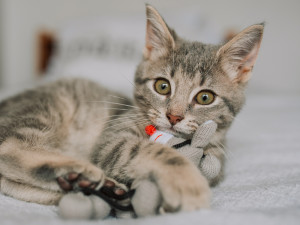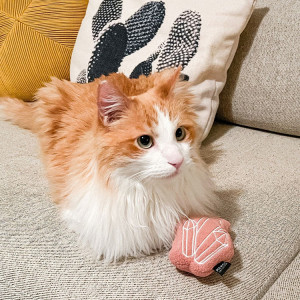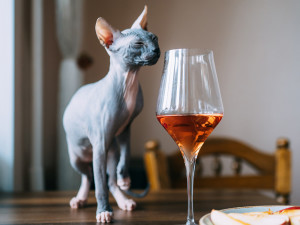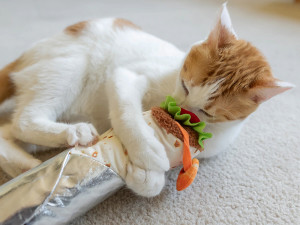Get This: While Your Cat Is High on Catnip, They’re Also Repelling Pests
Duuuude...where are the mosquitos?

share article
Our cats love catnipopens in a new tab, and we could spend hours watching videos of them get zooted on the green stuff. They have fun, and we watch them roll, purr, drool, and act like what we would imagine would happen if they were overtaken by an evil cat-spirit. As a cat parent whose cat is one of the 40 percent of felines who isn’t affected by catnip, I’m jealous of the ones whose fur-babies go absolutely bonkers over it. But, it turns out, catnip is more than just a good time for everyone — it’s also a natural pest-repellent.
How Does Catnip Work?
Catnip, which also goes by catmint, catwort, field balm, and by its binomial name, Nepeta cataria, is a perennial herb and a member of the mint family.
Although it transforms some felines into biting-and-scratching, but cute, demons, it’s completely safe to give it to cats. The plant, which is also popular to grow as an herb, is a muted green and can grow up to three feet tall. It has fuzzy stems and jagged leaves shaped like the pointed edge of a spear. Its many small, light purple flowers blossom between July and October. Another plant also has catnip-like effects: silver vine (Actinidia polygama), called “matabi” in Japanese.
“Catnip and silver vine are completely different plant species, but produce compounds that share very similar chemical structures that have six membered ring fused to five member ring containing oxygen,” explains Masao Miyazaki, PhD, DVM, who led the study. “These compounds induce an instinctive behavior comprising licking, chewing, rubbing, and rolling to cats.”
To summarize, catnip works because it contains a naturally-occuring chemical called nepetalactone, which gets cats “high.” Silver vine contains a similar bliss-inducing chemical called nepetalactol. Every cat responds to these substances differently. Some mellow out, some go wild, some are reduced to a purringopens in a new tab stupor, and some cats don’t feel anything at all. Even wild members of the feline family, such as lions, tigers, and bobcats, can experience the effects of catnip.
Smelling nepetalactone stimulates the opioid system in the feline brain, resulting in a feel-good response, according to a 2021 studyopens in a new tab published in the journal Science Advances.
Catnip As a Pest Repellent
That study, conducted by researchers at Iwate University in Japan, did more than just explore howthese chemicals make cats of all sizes happy. They also learned that cats’ attraction to them isn’t just really, really cute: it may also serve a biological purpose.
Nepetalactone is a natural mosquito repellent, and it beckons cats towards it with its fragrance and euphoria-inducing reaction. This self-anointing behavior with catnip and silver vine is uniquely feline. Dogs, however, were completely blasé about catnip.
But cats aren’t alone in their self-anointing behavior. Some other wild members of the animal kingdom use substances to keep pests at bayopens in a new tab. Spider monkeys rub themselves with leaves from the piper plant, a natural insect repellent. The white-nosed coati, a member of the raccoon family found in North, Central, and South America, ranging from southern Arizona to northwestern Colombia, uses citrus fruits to ward away pests. It’s easy to surmise why this happens—parasitic pests, such as mosquitoes ,can carry an array of diseases and not to mention, itchy bug bites are enough to drive anyone wild.
Why Do Cats Rub Their Faces on Catnip?
Cats love to bite, chew, roll over, rub against, and huff the aroma of catnip. This adorable behavior, which can turn them into either drooly and zonked-out or hyperactive and spicy little creatures is their natural response to nepetalactol. Cats’ compulsion to rub their faces all over their catnip toys, or a pile of loose leaves, also makes the chemical a more effective pest repellent, according to a follow-up studyopens in a new tab from the same team at Iwate University.
To carry out the study, researchers gave a synthetic cocktail of chemicals corresponding to the chemicals found in intact and damaged leaves to a group of cats. The after-effects were consistently more prolonged in the mixtures associated with damaged leaves.
When cats rub and bite catnip or silver vine, the damaged plant emits higher levels of nepetalactone, which gives kitty a stronger chemical defense against mosquitoes and activates their instinctive urge to keep playing. It may even boost their defenses against other parasitic insects. Further study is needed to understand why felines are so attracted to catnip and silver vine, but researchers believe that this trait may be unique to felines.
“This is the biggest question,” says Miyazaki. “We think that only Felidae species acquired olfactory receptors for the bioactive compounds that are conserved among them but not other mammalian species.”
The researchers now want to look into the specific gene that causes this behavior in cats. Your cat shouldn’t have to worry too much about pests, but it’s still fun to let them go wild with catnip toysopens in a new tab. Playtime helps keep your feline happy and entertained!

Kat L. Smith
Kat L. Smith is a writer and editor based in Queens, New York. They have written for LIVEKINDLY about a wide range of topics related to sustainability, lifestyle, house plant care, and food. They share their apartment with their adopted dog, Layla, and Vivi, a one-eared cat.
Related articles
![Black kitten reaching for ice cream felt toy against bright yellow background with other copies of ice cream toys]() opens in a new tab
opens in a new tabWare of the Dog Makes Cat Toys?!
The indie dog brand has designed 10 adorably crafty catnip-stuffed toys.
![A Terracotta kit with planters.]() opens in a new tab
opens in a new tabThis Catnip Grow Kit Provides Your Cat With a Houseplant They Can Actually Eat
If your loved ones with cats can’t keep a plant alive, this is the gift for them.
![Grey Sphynx cat with glass of wine]() opens in a new tab
opens in a new tabHow is Cat Wine Still a Thing?
It’s five o’clock somewhere, but read this before you share a glass with your pet.
![White and tan cat playing with a taco toy]() opens in a new tab
opens in a new tab14 Food-Themed Toys to Tease Your Cat
From burritos to baguettes, these catnip-stuffed toys may curb your cat’s munchies.






